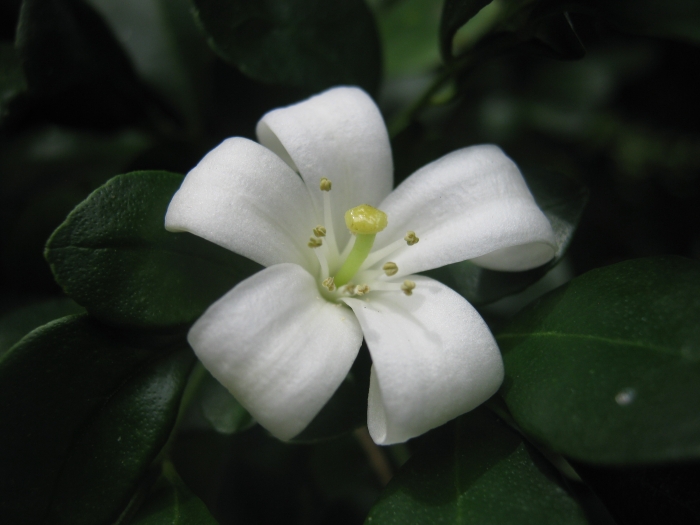Orange Jasmine
(Murraya paniculata)
Orange Jasmine (Murraya paniculata)
/
/

Andrés Montesinos
Public domain
Image By:
Andrés Montesinos
Recorded By:
Copyright:
Public domain
Copyright Notice:
Photo by: Andrés Montesinos | License Type: Public domain | License URL: https://creativecommons.org/public-domain/ | Uploader: Androz | Publisher: Wikimedia Commons | Title: Flor-Murraya_manipulata.JPG | Notes: {{Information |Description= ''Myoporum floribundum'' (cultivated, labelled) Royal Botanic Gardens Melbourne, Australia |Source= digital photograph by author |Date= 2009-10-22 |Author= [[:en:User:Melburnian|Melburnian]] |Permission= see below |other_versio |










































































Estimated Native Range
Summary
Murraya paniculata, commonly known as Orange Jasmine or Chinese Box, is an evergreen shrub or small tree native to the subtropical and tropical regions of South Asia, Southeast Asia, and Australia. It typically grows to a height of 2-7 meters (7-23 feet) and is often cultivated as a shrub. This plant thrives in a variety of habitats including monsoon forests, coastal forests, and forest edges. It features glossy, dark green leaves and small, creamy-white flowers that are highly fragrant and bloom in clusters throughout the year, with peak flowering from spring to summer. The flowers are particularly showy due to their abundance and sweet scent, which can perfume the surrounding area. The resulting fruit is a small, orange to red berry that is attractive to birds.
Orange Jasmine is valued for its aromatic flowers, dense foliage, and versatility in the landscape. It is commonly used as a hedge, screen, or container plant, and can also be trained as a bonsai. It adapts well to urban conditions and is relatively low-maintenance, tolerating pruning and shaping. In cultivation, it prefers full sun to part shade, well-drained soils, and regular watering, although it is drought-tolerant once established. It is not particular about soil pH and can grow in a range of soil types. However, gardeners should be aware that Murraya paniculata can become invasive outside its native range, as seen in Florida and other parts of the world. It can also be susceptible to pests such as scale insects and sooty mold.CC BY-SA 4.0
Orange Jasmine is valued for its aromatic flowers, dense foliage, and versatility in the landscape. It is commonly used as a hedge, screen, or container plant, and can also be trained as a bonsai. It adapts well to urban conditions and is relatively low-maintenance, tolerating pruning and shaping. In cultivation, it prefers full sun to part shade, well-drained soils, and regular watering, although it is drought-tolerant once established. It is not particular about soil pH and can grow in a range of soil types. However, gardeners should be aware that Murraya paniculata can become invasive outside its native range, as seen in Florida and other parts of the world. It can also be susceptible to pests such as scale insects and sooty mold.CC BY-SA 4.0
Plant Description
- Plant Type: Tree, Shrub
- Height: 8-12 feet
- Width: 8-12 feet
- Growth Rate: Moderate
- Flower Color: White
- Flowering Season: Spring, Summer
- Leaf Retention: Evergreen
Growth Requirements
- Sun: Full Sun, Part Shade
- Water: Medium
- Drainage: Medium
Common Uses
Bee Garden, Bird Garden, Butterfly Garden, Fragrant, Hedges, Low Maintenance, Potted Plant, Street Planting
Natural Habitat
Subtropical and tropical monsoon forests, coastal forests, and forest edges in South Asia, Southeast Asia, and Australia
Other Names
Common Names: Orange Jasmine, Orange Jessamine, Mock Orange, Café De La India, China Box, Kamini, Orange Jessamine
Scientific Names: , Murraya paniculata, Murraya exotica, Murraya paniculata subsp. paniculata, Murraya paniculata var. omphalocarpa, Chalcas paniculata, Chalcas exotica, Murraya ovatifoliolata, Murraya sumatrana, Murraya omphalocarpa
GBIF Accepted Name: Murraya paniculata (L.) Jacq.